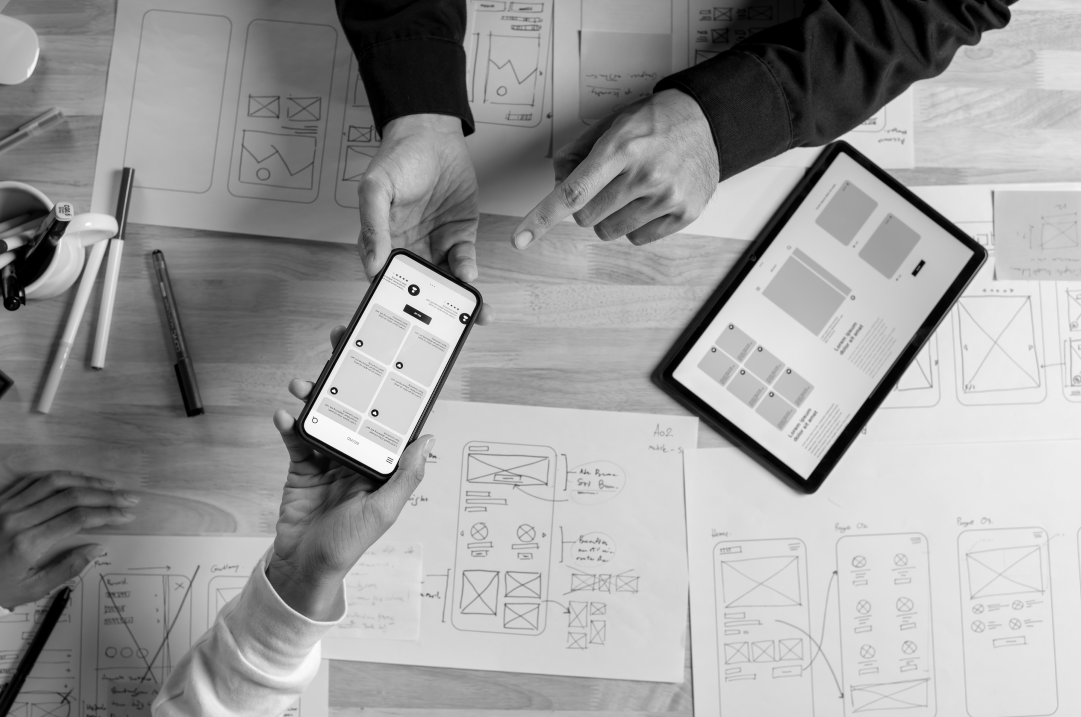You are building your startup, you’re focused on the solution you provide to your customers and your business model. You’ve faced many challenges and finally your product has come to life…what a great feeling! But, wait a minute…you need a consistent visual identity. One that represents your brand and transmits the right message to your audience. Not so easy peasy, right?
For a startup founder venturing into the labyrinth of visual design, the challenges loom large like storm clouds on the horizon. Creating a brand's visual identity in design terms can be daunting, akin to navigating uncharted waters without a compass. The first hurdle lies in deciphering where to even begin with the new logo – a tiny yet pivotal emblem that encapsulates the brand's essence in a mere image. The job of designers is to ease this journey by following essential golden rules of logo design, as this can be the most challenging part of a project. They can guide the different ways forward and help record design ideas effectively.
You as a founder, grapple with questions swirling in your mind like a tempest: What imagery best represents my brand's ethos? Which colors evoke the right emotions? What font conveys the intended message? Balancing creativity with practicality becomes a tightrope walk, with each decision fraught with significance.
Moreover, the founder doesn't usually have complete freedom. They must contend with limited resources – both financial and human – amplifying the pressure to get it right the first time. The fear of investing precious resources into a visual identity that misses the mark looms large, casting shadows of doubt over every design choice.
Yet amidst the chaos, glimmers of hope emerge. You seek solace in the wisdom of mentors, the guidance of design experts, and the power of iteration. Through relentless experimentation and trying new things, alongside unwavering determination, you embark on a quest to birth a logo that not only symbolizes your startup but also resonates with your audience on a profound level.
Thus, armed with equal parts courage and creativity, the startup founder ventures into the turbulent seas of visual design, ready to conquer the challenges ahead and emerge victorious.
What Are the Key Elements to Consider in Logo Design?
Key elements to consider in logo design include simplicity, versatility, relevance to the brand, scalability for different applications, and memorability. The logo should also reflect the brand's values, and the idea of your particular design should include a range of applications and elements associated with brand identity design. Think about things like product packaging, client presentations, and the choice of fonts for effective marketing headlines. The goal is to stand out across different platforms and relevant touchpoints for a cohesive visual identity.
Creating a Memorable and Timeless Logo
The art of designing an enduring logo lies in finding the perfect balance between contemporary appeal and lasting impact. Your logo should speak clearly about your brand's values while maintaining its relevance through changing times.
Building a strong conceptual foundation
When embarking on the journey of logo design, crafting a memorable and timeless logo is essential for ensuring your brand resonates with audiences both now and in the future. A truly iconic logo doesn't just reflect current trends; it embodies the essence of your brand in a way that transcends time. This begins with a strong conceptual foundation—what does your brand stand for, and how can that be distilled into a single visual mark that conveys the meaning of the mark?
Balancing clarity with meaning
The key is to focus on simplicity and clarity while imbuing the idea of your logo design with depth and meaning, ensuring a level of relevance and an emotional side or maybe even a little wit. Strive for a balance between uniqueness and relatability, allowing the logo to make a significant impact without being overly complex or confusing. Moreover, considering the logo's adaptability across various media and applications, such as a logo in a browser bar, will mitigate the risk of it becoming outdated as design trends evolve.
Creating lasting brand recognition
By anchoring your logo in authenticity and core brand values, you increase the likelihood of it leaving a lasting impression—one that is both recognizably yours and deeply ingrained in the minds of your audience for years to come.
Best Practices for Logo Design That You Should Follow
How do you create a logo design and visual identity that makes an impact? Start here.
Initial Research
The foundation of any good logo design lies in thorough preparation and understanding of your brand's context, particularly in the context of a website. Before diving into the creative process, taking time to gather insights and analyze the landscape can make the difference between a good logo and a great one.
Understanding your market landscape
When embarking on the journey of logo design, one of the most critical steps lies in conducting thorough initial research. This foundational phase serves as the bedrock upon which your brand's visual identity will be built. By diving deep into the landscape of your industry, analyzing competitor logos, and understanding the preferences of your target audience, you equip yourself with valuable insights that inform design choices.
Research-driven differentiation
Research allows you to grasp the visual trends that resonate within your market while also highlighting the gaps you can exploit to differentiate your brand. Beyond aesthetics, initial research helps clarify your brand's goals, values, and mission, ensuring that the logo you create authentically represents who you are as a company.
Impact on brand success
The importance of this step cannot be overstated, as skipping it can lead to a visual identity that misses the mark and fails to connect with your audience. Remember, a well-researched logo design process not only enhances creativity but also increases the likelihood of a successful and impactful brand presence in the crowded marketplace.
Know Thy Brand, Inside Out
Ah, the cornerstone of any creative endeavor: understanding the brand. It's not just about knowing the product or service; it's about delving deep into its soul, its aspirations, its quirks. Our brand identity should be an authentic reflection of who you are as a company. Without a clear understanding of your brand's values, personality, and mission, your visual identity runs the risk of being disingenuous or disconnected from your essence.
Consistency…is power! By understanding your brand inside and out, you can ensure that every visual element – from your logo to your color palette to your typography – aligns seamlessly with your brand's personality and resonates with your target audience consistently across all touchpoints.
Differentiation is also key for creating a distinctive picture of the brand, and incorporating a photographic style can enhance this differentiation. In a crowded marketplace, standing out is imperative. Understanding what sets your brand apart allows you to develop a unique visual identity that distinguishes you from competitors. By highlighting your brand's unique selling points through design, you can attract the kind of client or customer you want.
Keep It Simple
Ever heard of Occam's razor? Well, it applies here too. Your logo doesn't need to be an enigma wrapped in a mystery surrounded by a puzzle. Simplicity reigns supreme in the eyes of the public. Think Apple's iconic fruit or the Nike swoosh. A really simple logo can be instantly recognizable. Don't complicate things.
Keeping your logo simple is crucial for several reasons, primarily because simplicity enhances clarity, memorability, and versatility, especially when trying to attract potential customers. Showcasing simplicity is a good way to attract potential customers. An overly detailed design can hurt more than it helps. So it's important to keep all your design ideas in check.
Firstly, simplicity ensures clarity, allowing your audience to instantly grasp the essence of your brand without confusion or cognitive overload. A simple logo communicates your brand's identity succinctly, making it easier for consumers to recognize and remember amidst a sea of visual stimuli.
Secondly, simplicity breeds memorability. A clean and uncomplicated design is more likely to stick in the minds of consumers, becoming ingrained in their subconscious and facilitating recall when they encounter your brand in the future. Memorable logos have the power to leave some kind of impact, fostering brand recognition and loyalty over time.
Moreover, simplicity enhances versatility, enabling your logo to maintain its integrity across various platforms, sizes, and applications. Whether displayed on a billboard, website, or promotional merchandise like a coffee mug, a simple logo retains its impact and legibility, ensuring consistent brand representation across diverse mediums.
Colors: Don't Be a Rainbow Unicorn
Ah, colors – the spice of design life. But beware, young padawan, for too many colors can lead to visual chaos. Stick to an interesting palette that resonates with the brand's persona. And please, resist the temptation to use every shade in the Pantone catalog, as a poor idea can emerge when overwhelmed with options. A good idea will shine through when simplicity is prioritized. Remember, you're designing a logo, not a unicorn costume.
Typography: The Font of All Wisdom
Fonts are like people – some are bold and assertive, while others are delicate and refined, with an elegant typeface perfectly embodying sophistication. Choose wisely, for the font sets the tone of your brand's voice. Whether it's the authoritative serif or the friendly sans-serif, ensure it aligns with the brand's identity. And please, spare us the Comic Sans atrocities unless you're designing for a kindergarten.
Typography helps establish a visual hierarchy within your design, guiding your audience's attention and emphasizing key elements such as headlines, subheadings, and calls to action. By choosing the right typography, you can effectively communicate the most important information and improve overall readability.
A friendly piece of advice: consider your brand's personality, values, and target audience. Choose a typography that complements your brand identity and resonates with your audience. Also, prioritize legibility and readability when selecting typography, especially for body text. Avoid overly ornate or complex fonts that may hinder comprehension. Don't be afraid to experiment with different typography options; you can test how different fonts look and feel in various contexts to find the perfect match for your brand. Apart from this, seek inspiration from other brands, design trends, and typography resources. Pay attention to typography used in successful branding campaigns and analyze what makes them effective. Moreover, don’t forget to test your chosen typography across different platforms and devices to ensure consistency and readability. Adjust as needed to optimize the user experience across all touchpoints.
Scalability: Think Big, Think Small
Your logo should be as versatile as a chameleon at a color festival. It should look equally stunning whether it's splashed across a billboard or squeezed into the corner of a business card, similar to how the McDonald’s golden arches maintain their appeal. Scalability is key – because let's face it, a pixelated logo isn't a good look on anyone. Brands must adapt to a myriad of formats, platforms, and social media to reach their audience effectively. Consider every digital interface and print material.
In today's mobile-first world, where consumers access content on devices of varying screen sizes, a scalable logo ensures an optimal user experience. It remains recognizable and impactful regardless of the device or platform, enhancing brand visibility and engagement. Furthermore, a scalable logo eliminates the need for multiple versions tailored to specific sizes or formats, saving time and resources in design and production. It streamlines brand management and ensures consistency across all touchpoints, maximizing the return on investment.
A scalable logo should feature clean lines, minimal detail, and clear shapes to maintain legibility at different sizes and smaller sizes, especially when the company name is unique. Simplified designs are easier to scale without sacrificing visual impact or design flair. Opt for a bold, well-defined range of elements that remain distinguishable when scaled down. Avoid intricate patterns or fine lines that may become blurred or indistinct in smaller formats. Despite its size, a scalable logo should remain instantly recognizable as belonging to your company name brand. Focus on retaining key brand elements, such as color palette, typography, and iconic symbols or motifs. This might seem obvious but it’s not: maintain consistent proportions and spacing between elements to preserve the logo's balance and harmony across different scales. A well-balanced logo translates seamlessly across various formats, maintaining brand integrity.
Understand the Competition and Differentiation
Creating a distinctive logo requires awareness of your market and the courage to stand out. A strategic approach to analyzing competitors while maintaining your unique vision will help your brand make its mark.
Analyzing competitor design strategies
In the fierce arena of logo design, understanding the competition is paramount. As you embark on creating your visual identity, a thorough analysis of your competitors' logos will shed light on effective design strategies while pinpointing areas ripe for differentiation. Dive into their color choices, typography, and overall aesthetics; this will help you identify common themes within your industry that resonate with audiences.
Finding your unique visual voice
However, it's not just about mimicking success; it's about standing apart from a sea of familiar branding. Look for elements—be it a unique symbol, innovative use of negative space, or a bold kind of palette—that can position your logo distinctively, such as a symbol placed to the left of the brand name. This can be the perfect opportunity to communicate your brand values authentically through design elements that speak to your target audience, showcasing what makes your offering unique. Maybe you want to keep thinks simple and clean with parallel stripes. Or maybe you want to add a visual with a little humor. It's important to think through what will feel authentic to the brand.
Creating lasting market impact
By thoughtfully dissecting the strengths and weaknesses of competitor logos, you not only grasp the visual narrative of your industry but also carve out your own compelling story through your logo. A well-researched logo design not only captures attention but also ensures that your brand communicates its uniqueness, paving the way for a memorable impression in a saturated marketplace.
Test, Iterate, Repeat
Even Michelangelo didn't sculpt David in a day. Don't rush one of the most interesting parts of the process. Take your time, experiment, and don't be afraid to fail. Test your logo across different mediums, solicit feedback, and refine it until it shines brighter than a supernova. Remember, Rome wasn't built in a day, and neither was the perfect logo. It takes time to get your your perfect logo lockup.
No design is perfect from the get-go. By testing your visual identity with your initial target audience and stakeholders, you gain valuable insights into what works and what doesn't. Iterating allows you to refine your designs, making incremental improvements that enhance their effectiveness and resonance. The marketplace is dynamic, and consumer preferences evolve over time. By continuously testing and iterating your visual identity, you can adapt to changing trends, audience expectations, and competitive landscapes. This flexibility ensures that your brand remains relevant and impactful in an ever-changing environment.
Also, testing your visual identity with real users helps validate your design decisions. It allows you to gauge audience reactions, gather feedback, and identify areas for improvement. By incorporating user insights into your iterations, you can create a visual identity that resonates more deeply with your target audience.
Legalities: Don't Get Sued
Ah, the less glamorous side of design – legalities. Ensure your masterpiece isn't a copyright infringement waiting to happen. Conduct thorough research, dot your i's, cross your t's, and consult legal experts if needed. Because nothing kills the vibe faster than a cease-and desist letter.
Before finalizing your visual identity, conduct a comprehensive trademark search to ensure that your logo, brand name, and other visual elements do not infringe on existing trademarks. Too much similarity between you and another brand can lead to trouble. Registering your trademarks provides legal protection and exclusive rights to use them in commerce, reducing the risk of infringement claims. Original creative works, such as logos, graphics, and marketing materials, are automatically protected by copyright law upon creation. However, registering your copyrights with the appropriate authorities strengthens your legal standing in case of infringement disputes. Be mindful of using licensed or royalty-free images to avoid copyright violations.
Be cautious when incorporating third-party materials, like a logo maker, fonts, icons, or stock images, into your visual identity. Ensure that you have the necessary permissions or licenses to use these materials for commercial purposes and comply with any usage restrictions or attribution requirements.
And, really important! Registering a domain name that reflects your brand identity is essential for establishing an online presence. Ensure that your chosen domain name does not infringe on existing trademarks and comply with domain registration rules and regulations to avoid disputes over domain ownership.
So…who’s going to help me implement best practices for logo design?
As you may have noticed, these are a lot of things to consider when creating your visual identity- more than anyone would like. Don't risk it with a free logo maker. Trust Brightscout to ensure your brand shines brighter than a disco ball on a Saturday night. Contact us now to learn more about our design portfolio and what we can do for your business.






.png)
